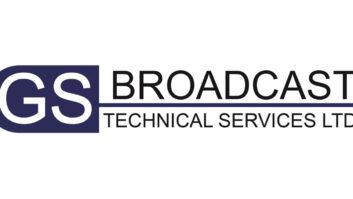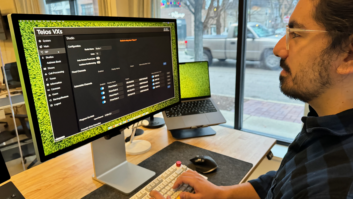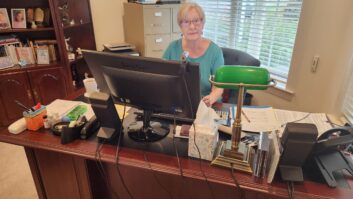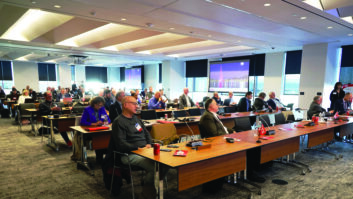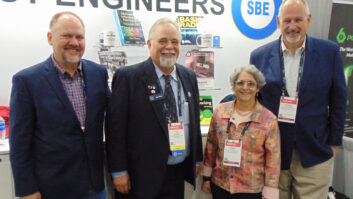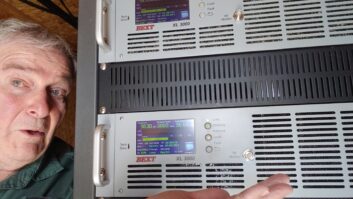Calculations and tables often are used to determine whether a broadcast site is compliant with the RF radiation exposure regulations of the Federal Communications Commission. There are situations, however, where the only practical way to determine compliance is to make measurements.
Broadcasters must comply with FCC regulations. Failure to do so can result in fines that have been as high as $25,000. But compliance should not be the only issue; RF safety must also be considered.
REGULATORY COMPLIANCE VS. RF SAFETY
Although every situation is different, the following simple rules apply to most radio and television broadcast installations:

There are several important points to keep in mind with regards to ground-level and rooftop level measurements at broadcast sites.
The Maximum Permissible Exposure limits are for spatially averaged exposure, which means the field strength is evaluated based on the average exposure over the height of a person. This is important because the RF field levels vary dramatically as a function of height above ground. The MPE limits for General Population/Uncontrolled exposure are instantaneous — no time averaging is allowed. However, the MPE limits for Occupational/Controlled exposure are based on the average exposure over any six-minute interval of time. Very few broadcast sites will qualify to use the higher MPE limits for Occupational/Controlled exposure.
Another important point is that exposure to high RF fields near AM towers is a regulatory concern but not an RF safety concern; RF burns from exposure to a tower are. Finally, because the MPE limit is higher outside of the human resonance band of 30 to 300 MHz, surveys at mixed sites with UHF-TV plus VHF-TV and/or FM antenna systems require test equipment that compensates for the difference in MPE limits unless stations can be powered down.
BASIC SURVEY TECHNIQUES
I always start a survey by moving about the site, constantly moving the probe in a somewhat oscillatory manner to cover as large a volume of area as possible. The goal at the beginning is to get a feel for the typical magnitude of the RF field levels without being concerned over absolute values. When a “hot spot” — where the peak RF field level is somewhat higher than surrounding areas — is detected, I note (and sometimes mark) the area so I can come back and make more precise measurements.
My immediate goals are to identify any areas where the peak RF field levels may exceed 50 percent of the FCC limit for General Population/Uncontrolled exposure and any areas where the peak RF field levels may exceed 50 percent of the limit for Occupational/Controlled exposure. I also look for all manmade or natural boundaries that separate spaces, such as a fence, the edge of a cliff, etc.
Once the immediate goals have been satisfied, it is time to quantify the maximum spatially averaged RF field level inside a defined area. For example, if there is a fenced compound with no other barriers or signs that separate the area, the goal is to quantify the maximum spatially averaged RF field level within that area.
I either report the field level in an area as a maximum or as a range. For example, if the maximum spatially averaged RF field level found is clearly less than 5 percent of the public MPE limit, that is what I report. I make no attempt to provide details beyond stating the maximum level within the fenced area.

Fig. 1: The drawing added to this photograph clearly illustrates the area where the RF field levels near the base of this guyed AM radio tower exceed the FCC’s MPE limit for public exposure.
If the RF field levels are more significant, I usually report a range. For example, I might report that the spatially averaged RF field levels within the fenced compound range from 20 to 45 percent of the FCC’s MPE limit for General Population/Uncontrolled exposure. Again, I do not bother to identify differences unless they are dramatic or impact either safety or compliance. In the second example, what difference does it make if the RF field level is 20 percent, 30 percent or 45 percent of the public MPE limit? All of these values are well below the MPE limit, and even when one factors measurement uncertainty, there are no regulatory issues. And since the reference point is the public MPE limit, there are definitely no RF safety concerns.
When the RF field levels vary dramatically within an area, yet still satisfy regulatory compliance concerns, I do provide more detail. I normally use either one of two techniques on my reports. I use either a photograph with shading added (this is convenient for a small area, such as around the base of an AM tower, see Fig. 1), or a drawing with color-coded areas that represent areas with different RF field level ranges (see Fig. 2).
MEASUREMENT ARTIFACTS AND SURVEY ERRORS
I frequently review reports of previous RF surveys and often am amazed at the errors that I find. The errors include:
• Reporting a field strength of several percent of the MPE limit at the base of an extremely tall tower. More often than not, the surveyor did not understand the need to frequently zero the instrument to compensate for thermal drift of the zero point. At sites like this, the magnitude of the RF field is usually below the minimum measurement capability of the survey instrument and the value that has been reported is actually zero drift.

Fig. 2: This example of a drawing with colored areas is used to show different spatially averaged RF field levels. This drawing is from a report that covers the RF field levels on the roads at California’s Mt. Wilson antenna farm.
• Reporting RF fields that are really scalar or voltage fields. This occurs when the probe (sensor) and the meter are at different voltage levels and the survey system functions as a voltmeter. A simple test to see if this phenomenon is occurring is to cover the head (sensor portion) of the probe completely with aluminum foil. If there is still a similar “field strength” indicated on the meter, that is what is happening. This problem frequently occurs when working near strong power line circuits or even fluorescent lights inside a building. One FM station engineer was told by the PE conducting the survey: “See, the RF fields are higher inside the transmitter room than near the tower.” He was making this statement while holding the probe near the fluorescent lights. A similar problem can occur at AM radio sites.
• Not using special averaging or using an incorrect technique. A rough rule of thumb is that the magnitude of the spatially averaged RF field at ground level at a broadcast site will be about 60 percent (typically within 50 to 70 percent) of the peak RF field at that location. This ratio holds when measuring in terms of equivalent power density in units of mW/cm² or W/m² but not when measuring in terms of volts per meter. Failure to consider spatial averaging can often mean the difference between finding a site compliant with the FCC Regulations and reporting non-compliance.
• Using a flat-frequency response probe in an environment that includes both UHF-TV and FM and/or VHF-TV antennas. A shaped-frequency response probe uses resistive-capacitive circuits at the point of detection in a manner similar to filter design, so the energy from various signals is automatically weighted in terms of a percentage of the applicable standard or regulation — for broadcasters in the United States, the probe follows the FCC’s MPE limits. In contrast, a Canadian broadcaster would need to use a probe shaped to Health Canada’s Safety Code 6 regulations.
• Subtracting one large number from another large number to try to determine a precise value for a small number.
I know this last item might not make much sense at first, but consider a landmark case in RF safety where the FCC did just that.

Dave Pinion, PE, of Hatfield & Dawson Consulting Engineers and the author, Richard Strickland, make measurements on the road at the Mt. Wilson antenna farm in August 2011.
They made measurements in the central area of the Mt. Wilson antenna farm outside of Los Angeles and determined that the total RF field strength was 160.5 percent of the MPE limit for public exposure. They arrived at this value by averaging approximately 10 spatially averaged measurements—nobody can argue with that. Consider that there were 22 emitters — FM and TV stations — contributing to this total. Back when this occurred, the field levels from TV stations varied significantly as a function of time as the programming changed from light to dark images, so even with the very best spatial averaging technique, one could easily expect to see a difference of 5 to 10 percent between each measurement even though all the stations remained operational.
But this is where the FCC inspectors failed to consider some basic scientific principles. They then had each of the 22 stations drop off the air one at a time and made two spatially averaged measurements at the same location. They averaged the two measurements and then subtracted the results from their 160.5 percent baseline! One of the FM stations was found to be about 80 percent of the MPE limit or 50 percent of the total weighted field strength. Therefore, the remaining 21 stations contributed a total of about 80 percent of the MPE limit or an average of about 4 percent each.
Given that the variance in the RF field due to programming and that the average of two measurements that could easily vary by 10 percent from the baseline even if all the stations remained on the air, how can one state that the station that dropped off the air had an RF field level contribution of 3.2 percent or 8.6 percent? The FCC fined three stations, including my client, which they claimed had contributions between 10 percent and about 12.5 percent of the MPE limit under their 5 percent rule. My client’s actual contribution — as proven by the overly conservative FCC calculations and narrow band measurements — was actually less than 3 percent of the MPE limit.
AM STATIONS REQUIRE SPECIAL TECHNIQUES
The major technical problem with measuring the electric field at AM radio sites is the potential for the human body to interact with the instrumentation and for the scalar field problem to occur.
The two most important techniques that I employ at AM sites are to connect the probe directly to the meter — do not use a cable — and use an insulated handle to hold the meter if the meter has a metal housing.
SURVEY DOCUMENTATION
Conducting an RF survey is only the beginning — it is just as important to document it correctly as it is to conduct the survey correctly. I follow a basic rule when writing RF safety or RF compliance reports — the report should be understandable by anyone who reads it, not just someone who is familiar with the site. I use lots of pictures with descriptive captions imbedded in the body of the report, not at the end or in an appendix. Every photo has a description, not just a title.
The report provides: a description of what was measured; when it was measured; by whom it was measured; what test equipment was used, including a description of its capabilities and limitations; and the magnitude of the RF fields at various locations. Every report has a clear statement regarding safety and compliance. All of my reports feature an executive summary so that the reader can get all the important points in a maximum of three pages. RF safety reports, as compared to compliance reports, also describe what the RF safety and regulatory risks are my recommendations. Recommendations may include additions or changes to signage and procedural changes.
Richard Strickland operates RF Safety Solutions LLC from his home office on Long Island in New York. He has focused on RF safety issues for almost 20 years.
Read his past RF Safety articles under the Columns tab.
SPATIAL AVERAGING
Summary: Spatial averaging is an important technique that can be used in assessing an RF environment. It is important to consider:
• where spatial averaging is inappropriate and potentially dangerous.
• the importance of spatial averaging in reducing the amount of measurement uncertainty in various RF environments.
• the practical implementation of spatial averaging.
• the variables for spatially averaged measurements.
WHERE NOT TO USE SPATIAL AVERAGING
Spatial averaging cannot be used without first considering the biological basis of the FCC regulations and major worldwide standards. The most grievous misuse of spatial averaging occurs when an individual is exposed to a very strong RF field over part of his or her body when in close proximity to an antenna. For example, this can happen when a person climbing a tower winds up with his or her head in the aperture of a TV or FM radio antenna. It would be biologically unsound to allow exposure to 1,000 percent of the MPE limits to the climber’s head using the logic that his head is equal to about 10 percent of his height. A similar situation can occur with the panel, or sector, antennas used for wireless services, although the field levels from these systems are much lower. This situation can be even more dangerous if the source operates at microwave frequencies, where the risk to the eyes is much higher.
USING SPATIAL AVERAGING TO REDUCE MEASUREMENT UNCERTAINTY
The RF field levels from a TV or FM broadcast antenna are normally quite low at ground level and increase as a function of elevation above the ground with a peak field level occurring at an elevation of λ/4 above the ground. For FM stations, this means that the peak fields occur at roughly 2-1/2 feet above the ground. The field intensity then drops off as the elevation is increased before they begin to increase again. The ratio of field strength from peak to null is typically 8:1 or greater.
Dave Pinion makes a spatially averaged measurement.

Multi-signal environments, typical of the many broadcast antenna farms, are far more complicated because of the various wavelengths and the interactions that take place between fields near ground level. Field levels in these environments vary dramatically in all three dimensions and as a function of time. Even spatially averaged measurements will not be totally repeatable. Field levels also vary due to the interaction of the surveyor’s body with the field.
Even with all these variables to be considered, spatially averaged measurements will be far less variable and more meaningful than making measurements based on looking for spatial peaks.
MAKING SPATIALLY AVERAGED MEASUREMENTS
Some regulations and standards, such as IEEE C95.1, suggest making a series of measurements in a vertical line in increments of 20 centimeters. Although this technique provides some improvement over more random measurements, it has limited accuracy and is very time-consuming. The accuracy of this technique is limited both because of the small number of data points and because the fields may be changing faster than one can make measurements. One should note that 20 centimeters is greater than the distance between a peak and a null from a typical cellular system.
Modern survey instruments are designed to make literally hundreds of measurements during a single spatial average. The technique employed is simple. Pressing a key on the instrument begins data acquisition at a fixed rate that continues until another (often the same) key is pushed. A typical logging rate is 32 data points per second. Thus, if a surveyor moves the probe in a vertical line for about 10 seconds, the resultant spatial average will be based on more than 300 measurements. If the movement of the probe is at a reasonably constant speed, then the spacing between measurements will be similar.
VARIABLES THAT IMPACT SPATIAL AVERAGING
An experienced surveyor usually can make fairly repeatable spatially averaged measurements. However, the more non-uniform the field levels are, the greater the variance that can be expected. The fields at complex broadcast sites can vary dramatically in intensity over a distance of a few inches in any direction. It often requires at least four to five spatially averaged measurements in the same location to have the confidence that a reasonably accurate measurement has been made. And it is not just a matter of averaging the spatially averaged measurements. Experience helps the surveyor to learn which measurements should be ignored.
Assuming that the surveyor does not move his or her feet, the averages can vary because of a non-uniform rate of speed and/or because the probe is moved over a slightly different area. If field levels are highest at head height, a slight delay in stopping the measurement adds a disproportionate amount of energy from the highest field area to the average. Similarly, if the highest field levels are near the ground, a slight delay in starting to move the probe after pushing “start” can have similar results.
If the surveyor moves his or her body and attempts to make spatial averages over the same point on the ground, one often sees large differences in readings due to the influence of the surveyor’s body on the measurements. In some cases, the body can block the energy from reaching the area being measured. In other cases, the probe may detect energy that is a combination of the actual field and of some additional energy that reflects off the surveyor’s body.
One highly regarded expert in the field who has made thousands of spatially averaged measurements believes that it is very difficult to repeat the same measurement within 5 percent, even when the greatest care is taken. This assumes that the surveyor does not move and attempts to measure the exact same spot, and that nothing changes in the fields that are being measured.
Realistically, if a series of spatially averaged measurements are within 10 percent of the mean, the surveyor is being very careful.
ENHANCED SPATIAL AVERAGING TECHNIQUE
If a series of spatially averaged measurements made with the surveyor in one position indicates that the field levels are close to the MPE limits, it is necessary to make additional measurements to average out the effects of the surveyor’s body on the measurements. In addition, although the probes are rated as isotropic, they are not entirely uniform in terms of sensitivity depending on the probe orientation vs. the energy source.
The best way to average out the probe variables and the impact of the surveyor’s body is to perform four to five spatially averaged measurements while standing in one position and then do the same thing in a minimum of four positions, moving roughly 90 degrees between each set of measurements. It is critical to make sure that all measurements are always made with the probe positioned over the same point on the ground — marking the roadway or putting a stone on the ground makes it easier to find the same spot. The field strength is then the average of the field strengths measured with the surveyor in each of four positions.





